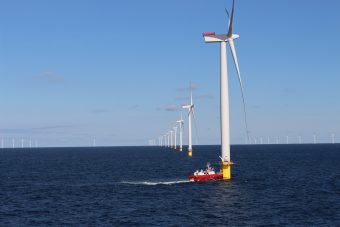
The recent flurry of UK wind power records continued today, as analysts confirmed Scotland generated power equivalent to the country’s entire electricity demand on four consecutive days late last year.
WWF Scotland, drawing on data from WeatherEnergy, reported all of Scotland’s power demand was matched by output from wind turbines on the 23rd, 24th, 25th, and 26th of December.
The period also saw Scotland set a new record for total daily wind power output, with 74,042MWh of electricity sent to the National Grid on Christmas Eve. Over the course of the day, wind farms met 132 per cent of Scotland’s electricity needs.
“These are two spectacular achievements, which underline the massive progress Scotland is making in securing an ever increasing proportion of its electricity needs from wind power and other clean renewable sources,” said WWF Scotland’s director Lang Banks. “Scotland can be proud that its record-breaking wind power output at the end of December, and resulting export of excess electricity through interconnectors to England, greatly contributed to what also proved a record-breaking week for wind power across the entire UK.”
The news comes just days after separate data for the whole of the UK revealed new half-hourly, daily and weekly records were set on the 23rd, 24th and 25th December, with nearly a third of UK electricity coming from wind on Christmas Day.
It also follows a new analysis by Carbon Brief, which revealed that over the course of 2016 wind power outperformed coal power for the first time. Coal’s total share of the power mix slumped to 9.2 per cent, its lowest level of output since 1935, while wind power accounted for 11.5 per cent of UK electricity.
Banks urged the Scottish government to build on the success of the country’s renewables sector. “Later this month, the Scottish Government is expected to publish its new energy strategy,” he said. “We hope these latest wind power records embolden Ministers to aim high when it comes to the role renewables play in their forthcoming strategy especially in areas beyond the power sector, such as heat and transport.”
Karen Robinson of WeatherEnergy said the recent records were part of an encouraging trend. “It was only as recently as August 2016 that we first recorded a day where wind powered electricity generation exceeding demand,” she said. However, thanks to increasing levels of renewables capacity and improved energy efficiency reducing power demand, we’re starting to see more and more such days.”
Further records are expected in the coming years as the UK continues to expand its offshore wind capacity.
Late last week, developer Vattenfall announced it was reviving plans to extend the Thanet offshore wind farm by adding 34 more turbines to the 100-turbine site.
Meanwhile, this weekend saw the first 6MW Siemens turbine installed at the 402MW Dudgeon Offshore Wind Farm.
The first of 67 turbines was installed safely on 7 January by A2SEA’s specialist SEA CHALLENGER vessel, completing a major milestone for the project off the Norfolk coast, which is co-owned by Statoil, Masdar, and Statkraft and is expected to provide clean power for up to 400,000 households.
However, industry insiders remain concerned about the prospects for the onshore wind industry. The government has effectively halted subsidies for new onshore wind project, sparking criticism that the lowest cost form of new generation capacity available in the UK currently is being denied the route to market that is being offered to more costly technologies.
Source: businessgreen.com

